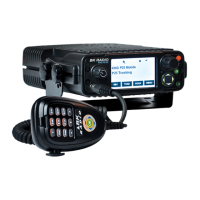
Do you have a question about the BK Radio KNG M-150 and is the answer not in the manual?
Safety warnings for radio operation, including proximity to blasting caps and explosive atmospheres.
Information on RF energy exposure, FCC occupational use requirements, and compliance standards.
Details FCC regulations regarding RF energy exposure limits for mobile 2-way radios.
Explains how the radio complies with national and international RF exposure standards and guidelines.
States compliance of the digital apparatus with Canadian ICES-003 standards.
Procedures for controlling RF exposure to ensure compliance with exposure limits.
Provides website for additional information on exposure requirements.
Details on different KNG radio models and their respective frequency ranges.
Lists factory-installed options available for KNG radios, identified by part numbers.
Describes the function of the combined power and volume knob for the radio.
Explains LCD touch screen, LED, USB port, channel select, buttons, and navigation.
Details the touch-activated buttons on the LCD display and their functions.
Details the meaning of various icons and indicators displayed on the radio's screen.
Describes how channel information is displayed on the LCD screen and customizable options.
Explains how functions can be assigned to buttons and menu items for trunk and conventional modes.
Lists specific functions assignable to buttons and menu options across different modes.
Details the functions of the microphone element, keypad, and selector switch.
Explains the Push-To-Talk, Function Buttons, Alphanumeric Keypad, and Function Select operations.
Describes how to toggle functions and access menus via the LCD touch screen.
Explains using the navigation wheel and menus to select functions and navigate options.
How to use the channel/zone selector knob for navigation and selection.
Methods for selecting channels/zones via buttons, menus, or direct keypad entry.
Step-by-step guide on powering on, setting volume, and selecting channels for receiving.
Steps for transmitting, including PTT usage, microphone technique, and checking transmit indicators.
Process of registering the radio with a trunking system and associated LED indications.
How to add channels to create a Command Zone using the Channel Add/Delete function.
Procedure for removing channels from a Command Zone and its implications.
How receive and transmit code guards work for analog and mixed-mode channels.
Using CTCSS/CDCSS for analog selective calling and NACs/TGIDs for digital selective calling.
Explains receiver and transmitter capabilities for analog, digital, and mixed modes.
How transmissions work in mixed mode when hold time is active.
How Channel Scan monitors activity on selected channels within a zone.
Adding or removing channels from the scan list for monitoring.
Responding on the transmit frequency of the received channel during scan.
Scanning trunking and conventional channels simultaneously.
How two channels are designated as priority channels for monitoring.
How to select and assign priority channels, either radio-wide or zone-specific.
How voted channels in multicast systems are selected based on signal strength.
How Zone Scan monitors programmed channels within designated Zone Scan zones.
Adding or removing zones from the list for scanning.
Steps and requirements for loading encryption keys and configuring the radio for secure communication.
How to enable secure transmission and assign encryption keys for transmission on channels.
How selecting a keyset influences the encryption keys used by the radio.
Manually requesting an encryption rekey from the Key Management Facility (KMF).
How to view and select active encryption keysets.
Method to remove all encryption keys from the radio for security.
How users can select and assign Pick List functions to specific channels.
Assigning CTCSS/CDCSS Code Guards to analog or mixed-mode channels.
Assigning Network Access Codes (NACs) to digital or mixed-mode channels.
Assigning Talk Group IDs (TGIDs) to digital channels for group communication.
Assigning encryption keys to encrypted channels that are not locked.
Selecting encryption keysets for use with digital or mixed-mode channels.
How to initiate and what happens when an emergency call is received by the radio.
Sending and receiving text messages on Digital Conventional P25 channels.
Procedures for selecting, composing, and sending text messages.
How to send status updates to individual radios, groups, or dispatch.
Receiving two-tone, DTMF, or MDC1200 pages on analog channels.
Sending and receiving Call Alert messages on digital channels.
How to check the availability of another KNG radio using its P25 ID.
Adjusting the display brightness using Auto, Off, Dim, Medium, or Bright settings.
Sending or receiving programmed information between BK Radio products using a cloning cable.
Settings for locking keypad or all controls to prevent accidental changes.
Accessing GPS functions, viewing coordinates, and sending GPS information.
Temporarily disabling other KNG radios using unit ID and re-enabling them.
Steps to enter programming mode, including password entry.
Editing information displayed on the radio's programmable lines.
Setting or resetting the user password for keypad programming mode.
Configuring system-wide priority channels for monitoring.
Enabling transmission on the programmed Priority 1 channel during priority scan.
Assigning priority channels on a zone basis and their monitoring during priority scan.
Editing or resetting the radio's P25 Unit ID.
Setting the time the radio waits before resuming scan after receiving a call.
Adding new Standard or Command Zones to the radio's configuration.
Removing existing zones or editing their parameters like label and priority channels.
Enabling DTMF tone generation during transmit and selecting characters.
Navigating to and editing individual channel parameters.
Setting or clearing the receive frequency for a channel.
Configuring receive modes (Analog, Digital, Mixed) and code guards.
Selecting between Normal and Selective squelch modes for signal qualification.
Selecting and programming entries in the unit-to-unit call list.
Programming or editing the label and P25 ID for a call list entry.
Selecting analog bandwidth (Narrowband/Wideband).
Setting transmit power levels for channels.
Setting or clearing the transmit frequency for a channel.
Setting the transmit mode (Analog, Digital, Mixed) for channels.
Configuring transmit CTCSS/CDCSS tones.
Configuring transmit Network Access Codes (NACs).
Programming User Selectable TGID Lists for group communication.
Entering or editing CTCSS values for digital code guards.
Entering or editing Network Access Codes (NACs) for channels.
Entering or editing Talk Group IDs for group communication.